REVE Chat Version 4.0
Version 4.0
Upgrade your website to an IM platform & beyond
Blending the strengths of IM and Live Chat
Upgrade your website to an instant messaging platform and beyond


Chatbots are now among the most preferred communication channels between customers and brands.
However, not many businesses get their chatbot strategy right and therefore fail to provide the kind of experience needed by customers.
In fact, the majority of AI bots sound less human and more robotic which dilutes the fun of conversations.
With 63% of customers preferring a chatbot to reach out to a brand, it’s important to write scripts in a way that makes the bot conversational in nature.
When the script is well-written and thought-through, the bot will always give relevant answers to customer queries and guide them through conversations without any hiccup.
For that reason, you should focus on how to write chatbot scripts so that your business is able to deliver a more humanized and improved experience to customers.
Scripts are easily the most important element of a chatbot. They decide whether a chatbot sounds human or robotic. In fact, conversational AI chatbots with well-written scripts always feel like humans and can engage in conversations on any scale. However, writing a good bot script is an art that you need to master to ensure value to customers.
There are different steps that can help you understand how to write bot script to deliver a more humanized experience to customers.
Let’s look into each of the ways in detail;
A good chatbot is one that is often created with a specific purpose in mind.
Whether to provide support to customers, guide them through the website, or take orders, there has to be a clarity of goals for your AI chatbot to perform optimally and handle queries efficiently.
Similarly, having targets in mind can help you design the bot flow and conversational scripts accordingly to ensure meaningful interactions with customers at each step of the way.
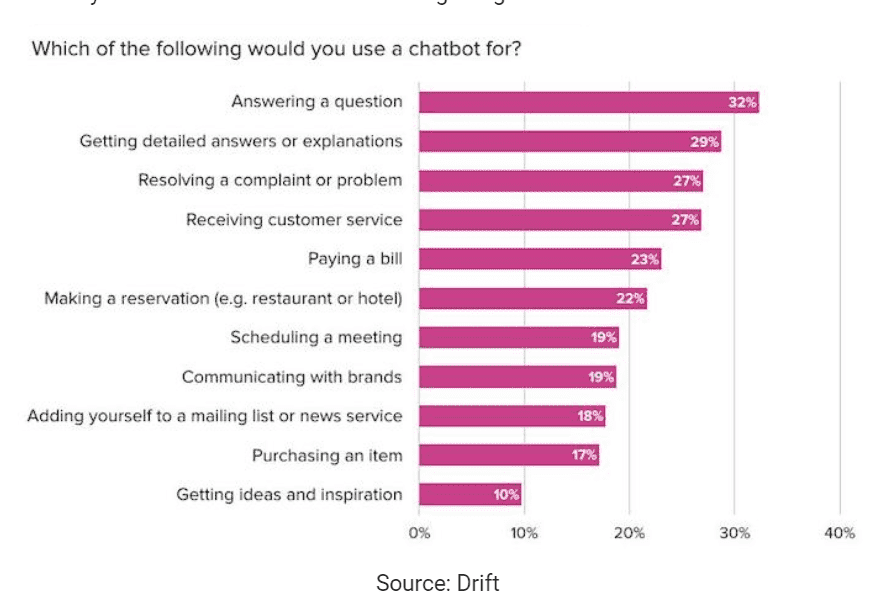
The scripts will decide the kind of personality you want the chatbot to have. It will also decide the attitude and behavior of the bot for a particular scenario.
The tone of your bot needs to align with the brand image you want to portray in front of the world.
After all, customers always find it easy to relate to chatbots that have a unique voice.
So, before creating the scripts, you should also do a bit of research with chatbot trends to get an idea of how others are playing the AI game and how can you stand out from the crowd.
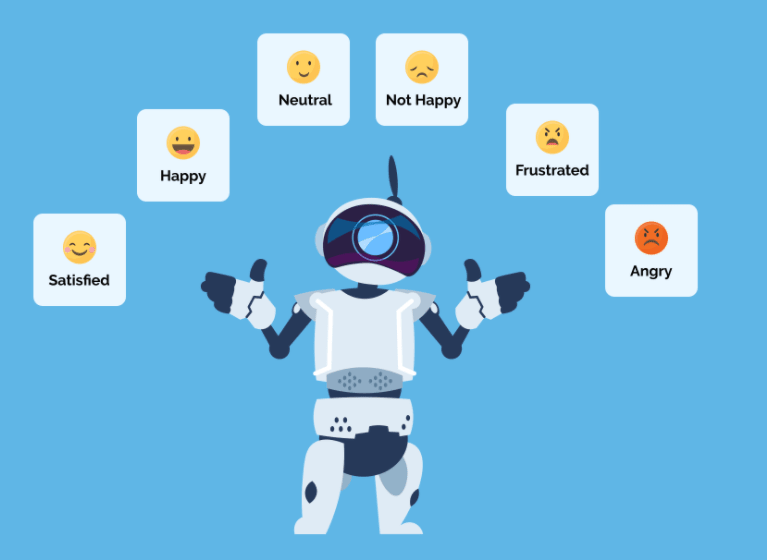
The best of chatbot scripts are always crafted based on the expected conversation flows between the users and the bot.
By building the dialogue tree, you would be aware of the sequence of questions customers might have and the supposed answer the bot needs to flesh out.
The purpose of building a conversation flow is to follow chatbot best practices, know the end goal of users, and then create the script based on that to ensure relevant responses most of the time.
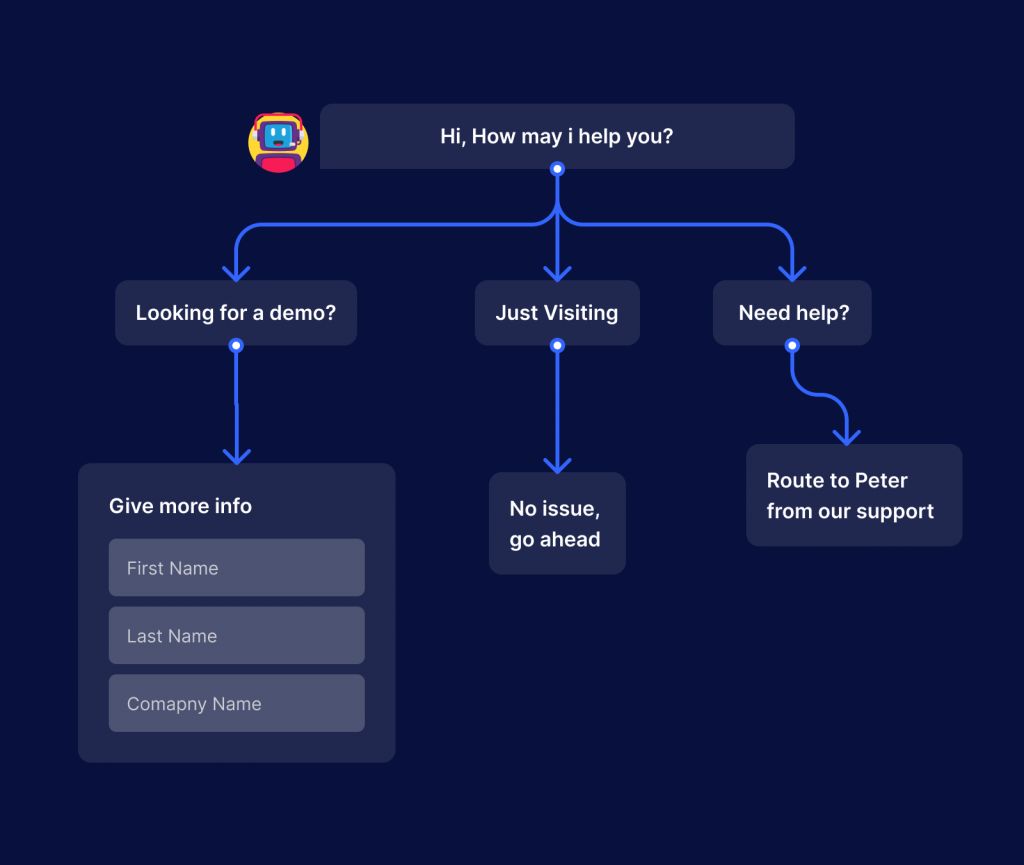
The dialogue tree above is a good example of how to get your chatbot conversational flow right.
From the very start, customers deserve to know whether they are talking with a robot or a human. You should never keep them in the dark on this issue.
Plus, this will also set the tone of conversations as then the nature of queries might also be less complex.
For that reason, you need to introduce the bot to the user and ‘list down the services’ or ‘the kind of help’ it can provide.
You’re also supposed to introduce the bot in a way that gives a complete idea of what the bot is intended for, quite like the conversational script sample below;
“Hi, My Name is Eva. I am a customer service bot. May I help you with a product search, order status check, etc.”
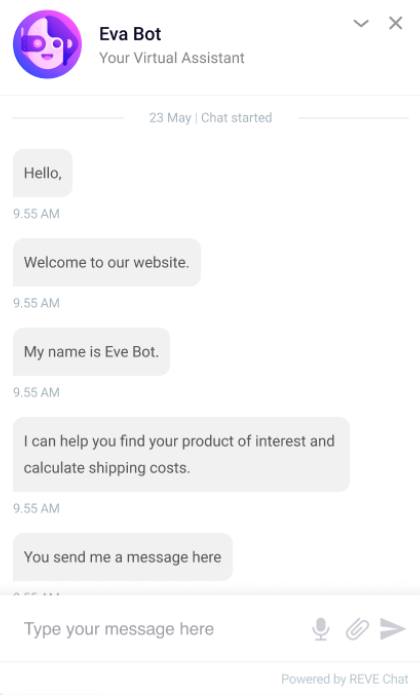
Whether you’re marketing a product or selling a service, personalization always works with customers.
And when your customer service chatbot is able to personalize the response, users are obviously impressed and feel a sense of specialness.
And when talked to at a personal level, customers always show a better response compared to other scenarios.
So, if you are writing a conversational script, make sure you consider personalizing your message.
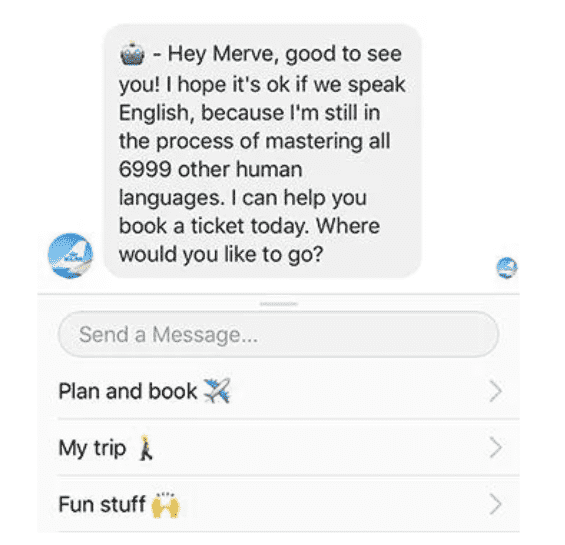
It’s your bot that needs to guide the conversations and direct customers to the next step.
Make sure the bot is proactive in approach when it comes to getting the interactions to move in the desired direction.
If there is a proper guidance in a step-by-step manner, it will always ensure a delightful chat experience for users.
For example, if you’re a SaaS company aiming to get customers to know your product, the chatbot response and scripts should be something on these lines;
“Looking for a quick product demo? Hello, I am your customer service bot. Type “book a product demo” or type “take me through the product”.
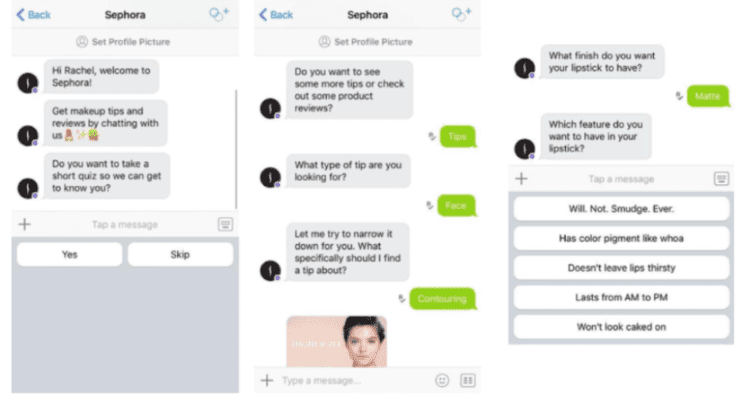
Even when users know they’re talking with a chatbot, they expect appropriate responses to some extent. And when the response is not relevant, it might put them off.
With the chatbot sentiment analysis feature getting advanced by the day, it would be a mistake to not consider the emotional appeal in the message.
Keeping this in mind, you need to ensure the chatbot script aligns with the user sentiment for a given situation.
Like for example, when a user is happy, the script should script reflect the same.
And if the user is displeased, make sure the bot’s tone is firm and professional.
Suppose, if the user shows interest in buying a product, the conversation script sample should have an element of excitement, like “Great!” Let me show you the product.”
And when the user is there with some complaint, a good chatbot script example and response could be like, “Oho, sorry to hear about that. Let me fix that for you.”
Lack of emotions can make the conversations feel drab and boring.
Even when users talk to a bot, they expect a certain level of expressions through words, emojis, etc. Without that, it feels like talking to a robot.
To avoid that situation, you should create bot scripts in a way that shows empathy, compassion, gratitude to the situations where it’s needed.
For example, if you were to handle a customer not happy with your product, avoid a robotic or standard chatbot script response like that;
“Kindly give us the product detail and let us look into that.”
The right response for such a scenario could be something along these lines;
Sorry to hear about that. We regret you have to face this situation. Let us fix the problem quickly so that you get the best out of our products.”
Or;
“Oh, we feel bad about this. But worry not. We’re gonna fix this quickly. Rest assured of a good product in quick time.”
No chatbot could ever be 100% accurate in every situation.
There will always be scenarios when the bot might feel unable to handle the customer query or feel clueless about the right responses.
For such cases, you should think of delivering a hybrid experience with human handover and live chat software at the right time.
It is important to incorporate the human handover as part of your conversation flow if you believe that the situation needs to be managed by human support.
The conversational scripts need to transfer the conversation to human agents in cases where the conversation goes beyond simple scenarios and needs actual assistance.
Chatbots are a multi-utility tool capable of serving a variety of purposes across industry verticals. They can add value to different aspects of customer communication whether for sales, marketing, or customer service. The best thing, you can easily find read-made chatbot scripts and customer service script templates for the most common usages and meet your business goals successfully.
Here are some chatbot scripts for common uses cases;
The conversational ability and flow of your chatbot will entirely depend on the types of scripts you have written for it. And to write a good script, you first need to be aware of what customers expect of your business and what kind of responses they like. This will help the bot deliver accurate responses in different types of situations.
However, the most important thing is to create human-sounding scripts and ensure a relevant and meaningful conversation experience for users. When this happens, you’re sure of giving customers the kind of human experience they always covet while talking to a bot.
Start a 14-day free trial, no credit card required
Stay updated with the latest trends and ideas we share
What happens when your business doesn’t have a well-defined lead management process in place? You might then struggle to track,...
In your business, you need information about your customers’ pain points, preferences, requirements, and most importantly their feedback. Now think this...
How does the future look like to you with Artificial Intelligence shaping most of our day-to-day tasks? Sometimes it feels...


